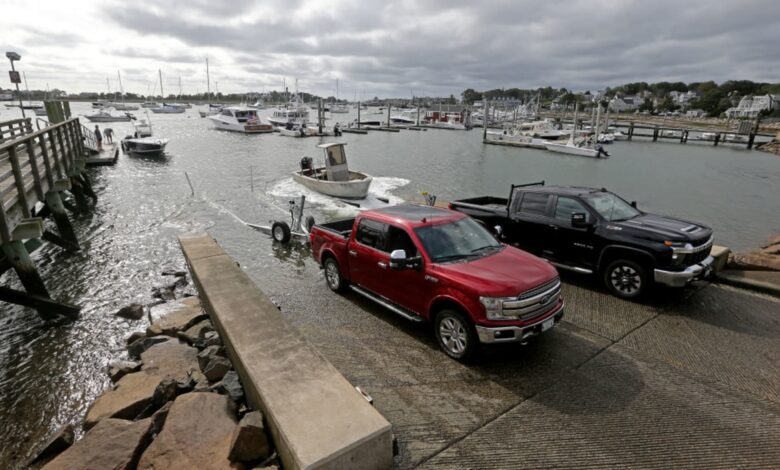Storm Lee bears down on New England, Canada with hurricane-force winds

Activity at the Scituate Boat Ramp prior to Hurricane Lee.
Stuart Cahill | Getty Images
Storm Lee toppled trees and cut power to tens of thousands Saturday as it lashed New England and eastern Canada, threatening hurricane-force winds, dangerous storm surge and torrential rains across an enormous swath even though its center had yet to come ashore.
The storm, still dangerous after being downgraded from hurricane to post-tropical cyclone, was expected to make landfall at or just below hurricane strength around the Maine-New Brunswick border Saturday afternoon, then turn to the northeast and move across Atlantic Canada on Saturday night and Sunday.
The storm skirted some of the most waterlogged areas of Massachusetts that experienced severe flash flooding days earlier, when fast water washed out roads, caused sinkholes, damaged homes and flooded vehicles.
But the entire region has experienced an especially wet summer — it ranked second in the number of rainy days in Portland, Maine — and Lee’s high winds toppled trees stressed by the rain-soaked ground in Maine, the nation’s most heavily wooded state.
“We have a long way to go, and we’re already seeing downed trees and power outages,” said Todd Foisy, a National Weather Service meteorologist.
The storm’s center was just off the southwestern tip of Nova Scotia, about 105 miles (170 kilometers) southeast of Eastport, Maine, and about 150 miles (240 kilometers) southwest of Halifax, Nova Scotia, the U.S. National Hurricane Center said at 11 a.m. EDT Saturday. It had maximum sustained winds of 75 mph (120 kph) and was moving north at a fast clip of about 22 mph (35 kph).
Its weakened state belies its reach — hurricane-force winds extend as far as 140 miles (220 kilometers) from the center, the National Hurricane Center said. Tropical-storm-force winds of at least 39 mph (62 kph) extend outward up to 390 miles (630 kilometers) — enough to cover all of Maine and much of Maritime Canada.
A dangerous storm surge will produce coastal flooding in Atlantic Canada, accompanied by large and destructive waves, forecasters said.
The storm was so big that it was causing power outages several hundred miles from its center. About 25% of Nova Scotia lacked power around midday Saturday.
“At this point, the storm is resembling a nor’easter,” said Sarah Thunberg, a National Weather Service meteorologist, referring to fall and winter storms that often plague the region and are so named because their winds blow from the northeast.
In typical tropical cyclones, Thunberg said, winds are concentrated around the eye. But Lee, a very large storm, has a wider wind field.
Federal aid is headed to Massachusetts after President Joe Biden declared an emergency Saturday.
Keith Oliver works a boat travel lift to take a boat out of the ocean at the Billings Diesel & Marine Service in preparation for the possible arrival of Hurricane Lee on September 15, 2023 in Stonington, Maine.
Joe Raedle | Getty Images
A tropical storm warning stretched from the New Hampshire-Maine border through Nova Scotia and Prince Edward Island to northern New Brunswick. A hurricane watch was in effect for New Brunswick and Nova Scotia.
Utilities reported nearly 200,000 customers without power from Maine to New Brunswick and Nova Scotia. Nova Scotia’s largest airport, Halifax Stanfield International, had no incoming or outgoing flights scheduled Saturday.
Peak gusts are projected to be 70 mph (113 kph) on the coast in eastern Maine, but there will be gusts up to 50 mph (80 kph) across a swath more than 400 miles wide, from Maine’s Moosehead Lake eastward all the way into the ocean, Foisy said.
Cruise ships found refuge at berths in Portland, while lobstermen in Bar Harbor — the touristy gateway to Acadia National Park — and elsewhere pulled their costly traps from the water and hauled their boats inland, leaving some harbors looking like ghost towns on Friday.
Two lobstermen — one of them Billy Bob Faulkingham, House Republican leader of the Maine Legislature — survived after their boat overturned while hauling traps Friday ahead of the storm, officials said.
The boat’s emergency locator beacon alerted authorities, and the two fishermen clung to the hull of the overturned boat until help arrived, said Winter Harbor Police Chief Danny Mitchell. The 42-foot boat sank.
“They’re very lucky to be alive,” he said.
Lee lashed the U.S. Virgin Islands, the Bahamas and Bermuda before turning northward, and heavy swells were likely to cause “life-threatening surf and rip current conditions” in the U.S. and Canada, according to the hurricane center.
Even as they prepared, New Englanders seemed largely unconcerned. Some brushed aside Lee as a glorified nor’easter.
Mickey Neuts-Richards, of South Portland, came out early Saturday to a coastal overlook hoping to see the storm’s fury on full display but was disappointed.
“I was just expecting more waves smashing up against the rocks a little bit, you know? I woke up this morning and I looked out the window and I thought it would be downpouring, but nothing,” she said. “Where’s Lee?”
In Canada, Ian Hubbard, a meteorologist for Environment and Climate Change Canada and the Canadian Hurricane Centre, said Lee won’t be anywhere near as severe as the remnants of Hurricane Fiona, which a year ago washed houses into the ocean, knocked out power to most of two provinces and swept a woman into the sea.
But it was still a dangerous storm. Kyle Leavitt, director of the New Brunswick Emergency Management Organization, urged residents to stay home, saying, “Nothing good can come from checking out the big waves and how strong the wind truly is.”
Lee shares some characteristics with 2012’s destructive Superstorm Sandy — both were once strong hurricanes that became post-tropical cyclones before landfall. But Lee is expected to produce far less rain than Sandy, which caused billions of dollars in damage and was blamed for dozens of deaths in New York and New Jersey.
Destructive hurricanes are relatively rare so far north. The Great New England Hurricane of 1938 brought gusts as high as 186 mph (300 kph) and sustained winds of 121 mph (195 kph) at Massachusetts’ Blue Hill Observatory. But there have been no storms that powerful in recent years.
=




